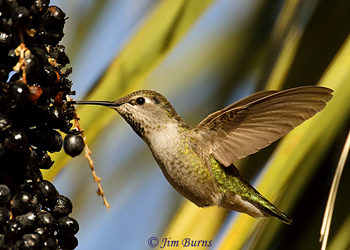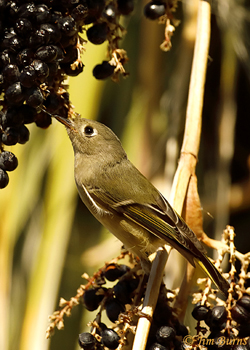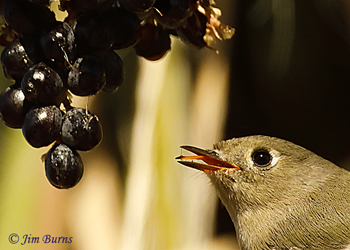Ruby-crowned Kinglet "nectaring" at Fan Palm Berries |
Ruby-crowned Kinglet with berry juice on tongue |
The usual cast of characters was coming periodically to the palm, Abert’s Towhees and White-crowned Sparrows gleaning fallen and discarded berries beneath the tree, woodpeckers, mockingbirds, thrashers, Verdins, and finches flying in to the fronds above, jumping onto the berry clusters themselves, and feeding on the plump fruit as the clusters swayed back and forth with the birds’ weight. Fascinating and photogenic, but nothing I hadn’t photographed in past years.
The birds coming to the actual clusters employed two feeding strategies, hang and graze or hover and pluck, and large (thrashers) and small (Verdin) alike were using both strategies. Things got more interesting when a Ruby-crowned Kinglet showed up. I had seen kinglets in the area, but not at the fruit. We know, of course, that kinglets glean insects, constantly, frenetically, and with much attendant wing flipping. This feeding style often identifies the species to the preclusion of even lifting binoculars, but I had never seen kinglets take berries or be interested in fruit.
Camera lifted now, I snapped away as a kinglet hung upside down, pecking at a berry several times before dropping into a nearby bush. Next time up the bird landed first, then hovered at the same berry. Doing what? Enlarging some frames on the back of the camera, I was surprised to see the sticky juice of the berry on the tongue of the hovering kinglet, proving this species employing the same strategy as hummingbirds at flowers, which in the latter case is called “nectaring.” Who knew?
But wait! My education into avian opportunism was just beginning. The next bird in was an immature male Anna’s Hummingbird, hovering around the berry clusters, apparently gleaning insects attracted to juice coming from berries pierced and damaged by the larger birds. I realized, though, the Anna’s was not flitting and darting, a strategy referred to as “gnatting,” which we see them doing in warmer spring weather. In the cool temperatures I hadn’t seen a gnat all morning, and this hummer was hovering several seconds at opened, broken berries, then moving on to others around the cluster just as if it were nectaring. Do hummers nectar at fruit like they nectar at flowers!?
Turns out, they do. When I consulted with Sheri Williamson, Arizona’s expert on everything hummer, she related to me she has “seen similar behavior with prickly pears that had been opened by other birds,” and that there are reports for persimmons, pears, and apples. Sheri thinks evaporation concentrates the sugars in fruit juices, and hummingbirds have learned to take advantage of this energy source. Who knew?
What all birders eventually come to know is that all species are opportunists. And why not? It’s a tough life out there, and to live with drought, habitat loss, winter weather, and Cooper’s Hawks, “opportunism” is synonymous with “survival.” That morning in December at the Fan Palm got me to thinking about other instances in my birding lifetime when I have been surprised by what I have seen birds do to survive, unexpected feeding strategies, birds doing things I’ve never seen in the literature. Stay tuned.


